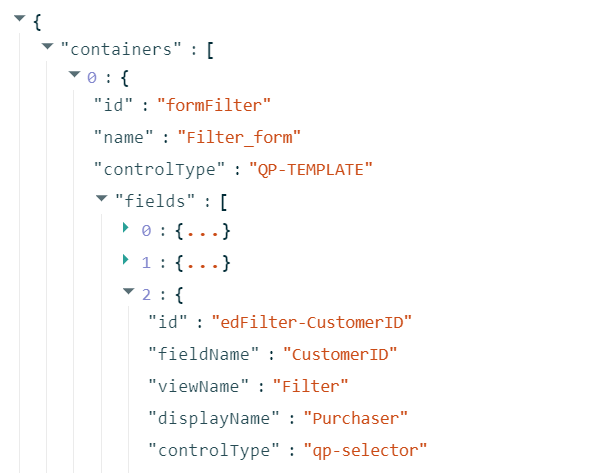Testing of the Modern UI: General Information
This topic describes WG containers and the WG containers’ structure that is used in tests for both the Classic UI and the Modern UI.
Learning Objectives
In this chapter, you will learn how to do the following:
- Get the structure of WG containers for a form
- Specify the names of WG containers
- Update tests for the Modern UI
Applicable Scenarios
You need to learn about WG containers when you are doing the following:
- Testing forms written in the Modern UI by using tests created for the same forms in the Classic UI
- Migrating tests from the Classic UI to the Modern UI
Overview of WG Containers
WG stands for wrapper generator. A wrapper is a part of tests that functions as an interface for tests for the UI of MYOB Acumatica. A wrapper describes the structure of UI elements located in different containers on the form—that is, it describes the structure of containers and elements they include.
A container is an entity that contains fields. Thus, a WG container is a
container of fields that are used in tests, and the wrapper describes the structure of WG
containers. Every WG container is referred to by a name. The name of the WG container is
generated automatically unless it is specified explicitly. For a container that has both the
view name and the ID specified, the name of the WG container is generated according to the
following rule: <view_name>_<container_id>.
The following screenshot shows an example of a file that describes WG containers.

The generation of wrappers does not depend on any features being enabled or disabled.
Access to the Wrapper of a Form
You can access a wrapper of any form that has been switched to the Modern UI by using a URL
with the following format:
<instance_URL>/ui/wrappers/<Screen_ID>. For example, you would
access a wrapper for the Invoices and Memos (AR301000) form on the
PhoneRepairShop instance with the following URL:
http://localhost/PhoneRepairShop/ui/wrappers/AR301000.
The following code is the beginning of the JSON file that is opened by this URL. The file shows the structure of WG containers of this form.
{
"containers": [
{
"id": "formDocument",
"name": "Document_form",
"controlType": "QP-TEMPLATE",
"fields": [
{
"id": "edDocument-DocType",
"fieldName": "DocType",
"viewName": "Document",
"displayName": "Type",
"controlType": "qp-drop-down",
"dataType": "String",
"containerPath": [
"formDocument"
],
"supportLocalizationPanel": false
},
{
"id": "edDocument-RefNbr",
"fieldName": "RefNbr",
"viewName": "Document",
"displayName": "Reference Nbr.",
"controlType": "qp-selector",
"dataType": "String",
"containerPath": [
"formDocument"
],
"supportLocalizationPanel": false
},
...]
}
]
}Structure of UI Containers
In ASPX files, tags, such as PXFormView and PXGrid, are used
to define containers for tests.
In the Modern UI,
the fields are organized in containers differently. For example, in the Classic UI,
the form contained three columns inside one PXFormView, as shown in the
following example.
<px:PXFormView ID="form" runat="server" DataSourceID="ds"
Style="z-index: 100" Width="100%"
DataMember="Filter" Caption="Selection" DefaultControlID="edAction">
<Template>
<px:PXLayoutRule runat="server" StartColumn="True" LabelsWidth="SM" ControlSize="XM" />
<px:PXDropDown CommitChanges="True" ID="edAction" runat="server"
DataField="Action" />
<px:PXSelector CommitChanges="True" ID="edStatementCycleId" runat="server"
DataField="StatementCycleId" />
<px:PXDateTimeEdit CommitChanges="True" ID="edStatementDate" runat="server"
DataField="StatementDate" />
<px:PXLayoutRule runat="server" StartColumn="True" LabelsWidth="S" ControlSize="XM" />
<px:PXSegmentMask CommitChanges="True" ID="edBranchID" runat="server"
DataField="BranchID" />
<px:PXSegmentMask CommitChanges="True" ID="edOrganizationID" runat="server"
DataField="OrganizationID" />
<px:PXCheckBox CommitChanges="True" ID="chkCuryStatements" runat="server"
DataField="CuryStatements" />
<px:PXCheckBox CommitChanges="True" ID="chkShowAll" runat="server"
DataField="ShowAll" />
<px:PXLayoutRule runat="server" StartColumn="True" LabelsWidth="S" ControlSize="SM" />
<px:PXCheckBox CommitChanges="True" ID="chkPrintWithDeviceHub" runat="server"
DataField="PrintWithDeviceHub" AlignLeft="true" />
<px:PXCheckBox CommitChanges="True" ID="chkDefinePrinterManually" runat="server"
DataField="DefinePrinterManually" AlignLeft="true" />
<px:PXSelector CommitChanges="True" ID="edPrinterID" runat="server"
DataField="PrinterID" />
<px:PXTextEdit CommitChanges="true" ID="edNumberOfCopies" runat="server"
DataField="NumberOfCopies" />
<px:PXLayoutRule runat="server" StartRow="true" LabelsWidth="SM" ControlSize="XXL" />
<px:PXTextEdit CommitChanges="True" ID="edStatementMessage" runat="server"
DataField="StatementMessage" TextMode="MultiLine" Height="55px" />
</Template>
</px:PXFormView>In the Modern UI, every
such column is a separate qp-fieldset container, as shown in the following
code.
<qp-template name="top-17-17-14" id="formFilter" wg-container="Filter_form">
<qp-fieldset slot="A" id="columnFirst" view.bind="Filter">
<field name="Date"></field>
<field name="VendorID"></field>
<field name="CustomerID"></field>
</qp-fieldset>
<qp-fieldset slot="B" id="columnSecond" view.bind="Filter">
<field name="CreateOnHold"></field>
<field name="CreateInSpecificPeriod"></field>
<field name="FinPeriodID"></field>
</qp-fieldset>
<qp-fieldset slot="C" id="columnThird" view.bind="Filter">
<field name="ProjectID"></field>
<field name="CopyProjectInformation"></field>
</qp-fieldset>
</qp-template>qp-fieldset is a minimum container entity in the Modern UI.
The wrapper generator treats it as a container entity. As a result, the structure of the
containers has changed.
If you do not specify WG containers explicitly, the wrapper will not be generated correctly
for a test written for the Classic UI to
work: Instead of one container with fields of the old PXFormVIew tag, you
will get three containers with fields (one for each qp-fieldset).
Summary
Current tests rely on the structure of the UI elements on the form of the Classic UI.
In order for these tests to work property, wrappers need to describe the same structure of the form. But in the Modern UI, the structure of the form is different. So for the current tests to work on the Modern UI, you need to specify the names of WG containers explicitly for most of the tags (except those for which the names are generated properly). You can specify names of WG containers in several ways. For more information on specifying the names of WG containers, see Testing of the Modern UI: Names of WG Containers.
